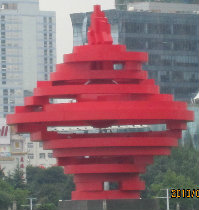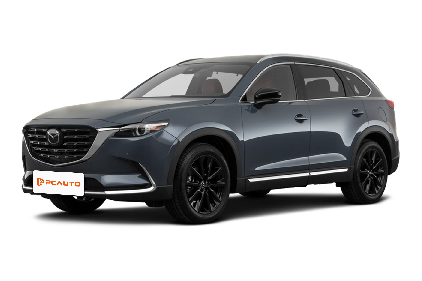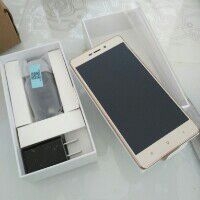Q
What is the difference between the Mazda CX-8 and CX-9?
Mazda's CX-8 and CX-9 might both be seven-seat SUVs, but they carve out distinct niches with differences in positioning, size, and powertrains. The CX-9, as Mazda's flagship SUV, stretches longer and wider, boasting a 2930mm wheelbase that translates to a genuinely usable third row – no token jump seats here. Under the hood, you'll find a 2.5-liter turbocharged engine cranking out 228 horsepower and a meaty 420 Nm of torque, making it the pick for families who want that extra punch and a touch more luxury in their daily drive.
The CX-8, on the other hand, leans into urban practicality. It's a smidge shorter overall but sits lower, though crucially, it retains that same 2930mm wheelbase for interior space. The Malaysian-spec sticks with a 2.5-liter naturally aspirated four-cylinder, good for 192 hp and 258 Nm. It's more about sipping fuel than scorching tarmac, which is a big plus for daily commutes. Inside, the CX-9 ups the ante with fancier materials like Nappa leather, while the CX-8 keeps things clean and functional with a more understated vibe.
Price-wise, the CX-8 tends to be the more wallet-friendly option in Malaysia. Both come loaded with Mazda's i-Activsense safety suite as standard, but the CX-9 typically offers a longer list of luxurious add-ons if you're willing to splurge.
So, choosing between them? It boils down to how much space you really need, whether you crave turbo power, and of course, your budget. And here's a local tip: Malaysia's tropical heat can be tough on turbocharged engines, so keep an eye on cooling. That naturally aspirated unit in the CX-8 might just be the more hassle-free choice for years of city driving, with potentially lower long-term maintenance costs to boot.
Special Disclaimer: This content is published by users and does not represent the views or position of PCauto.
Related Q&A
Q
Is the CX-9 fast?
The Mazda CX-9 is a large SUV with decent power performance in the Malaysian market. It's equipped with a 2.5-liter turbocharged engine, which outputs 227 horsepower and 420 Nm of torque. Paired with a 6-speed automatic transmission, the power output is smooth and sufficient to meet the needs of daily driving and high-speed overtaking. The 0 - 100 km/h acceleration takes about 8 seconds, which is relatively fast for a 7-seater family SUV. Although the acceleration performance of the CX-9 can't compare with that of performance SUVs, it's above average in its class. Especially, it has strong mid-range acceleration ability, making it suitable for driving on Malaysian highways. It's worth noting that the CX-9 uses Mazda's Skyactiv technology, which balances power and fuel economy. This is a good trade - off for Malaysian consumers. If you're after more powerful performance, you can consider some competitors with V6 engines. However, the CX-9 strikes a great balance between power, space, and fuel consumption, making it particularly suitable for Malaysian family users.
Q
How big is a CX-9 gas tank?
The fuel tank capacity of the Mazda CX-9 is 72.5 liters. This design can meet the needs of family long-distance trips, reducing the inconvenience of frequent refueling. For users in Malaysia, such a fuel tank size can provide good cruising range while taking fuel economy into account, which is especially practical when traveling across states or on self-driving tours. As a mid-to large-sized SUV, the CX-9 is equipped with an efficient power system. The fuel tank volume matches the fuel consumption performance of its 2.5-liter turbocharged engine, ensuring a reasonable driving range under comprehensive road conditions.
In addition, it is recommended that car owners regularly check the condition of the fuel tank and the oil circuit system and maintain good driving habits, such as smooth acceleration and reasonable use of cruise control, to further improve fuel efficiency. At the same time, pay attention to avoid exposing the fuel tank to the sun for a long time in Malaysia's hot climate, so as not to affect fuel evaporation and system safety.
Q
How many km per liter is a Mazda CX-9?
According to official data, the fuel economy of the Mazda CX 9 is roughly between 10 and 12 kilometers per liter of gasoline. The exact figure depends on driving conditions, road conditions, and vehicle configuration. For instance, the fuel consumption of the 2.5-liter turbocharged engine paired with a four-wheel-drive system is slightly higher than that of the front-wheel-drive version. In Malaysia, heavy traffic in the city may lead to higher fuel consumption, while driving on the highway can get closer to the ideal figure. Mazda's Skyactiv technology enhances fuel economy by optimizing engine efficiency and lightening the vehicle body, while maintaining power output. For consumers who are concerned about fuel consumption, it is recommended to regularly maintain tire pressure and engine condition and avoid aggressive driving. These habits can significantly affect the actual fuel-consumption performance. When compared with other SUVs in the same class, the CX-9's fuel consumption is at a medium level, but its handling and interior quality are still outstanding advantages, making it suitable for family users who pursue a great driving experience.
Q
How many kilometers can a Mazda CX-9 do?
As a mid-large SUV, the durability and mileage performance of the Mazda CX-9 mainly depend on daily maintenance and driving habits. Under normal use and regular maintenance, the CX-9 can reach a mileage of 200,000 to 300,000 kilometers or even more. Many owners have reported that the vehicle can maintain stable performance in the long run with good maintenance.
For users in Malaysia, the hot and humid climate may have a certain impact on vehicle components such as rubber seals and batteries. It is recommended to regularly check the cooling system and air-conditioning system, and replace the engine oil and filters according to the manufacturer's recommended maintenance schedule to extend the engine life.
The Skyactiv-G turbocharged engine equipped in the CX-9 has mature technology, and it performs well in terms of fuel economy and reliability, making it suitable for long-distance family trips. In addition, the rainy weather in Malaysia places certain requirements on the braking system and chassis anti-rust. It is recommended to regularly clean the chassis and check the thickness of the brake pads.
If you want to learn more about specific maintenance details, you can refer to the maintenance manual provided by Mazda Malaysia official or consult the authorized service center.
Q
What is the fuel consumption per 100km of the Mazda CX-9?
According to official data, the combined fuel consumption of the Mazda CX-9 in the Malaysian market is approximately 8.5 to 9.5 liters per 100 kilometers. The specific figure depends on driving habits, road conditions, and vehicle configuration. For example, the 2.5-liter turbocharged engine equipped in the vehicle has better fuel-consumption performance during high-speed cruising, while it will be slightly higher in congested urban areas. Malaysian car owners can refer to this data as a benchmark for their daily driving. At the same time, it is recommended to carry out regular vehicle maintenance, such as keeping the tire pressure normal and using the appropriate engine oil. These details can all help to optimize fuel economy.
In addition, Mazda's Skyactiv technology, with its efficient power system and lightweight design, provides ample power while also taking fuel-consumption performance into account. It is suitable for family users who value both the driving experience and practicality. If you have higher requirements for fuel consumption, you can also consider hybrid or pure-electric models. However, as a seven-seat SUV, the CX-9's fuel-consumption level is still competitive in its class.
Q
How long will a Mazda CX-9 last?
As a mid-large SUV designed mainly for family use, the Mazda CX-9 typically shows a durability of 150,000 to 200,000 kilometers or even more in the Malaysian market. The actual lifespan depends on the owner's maintenance habits and driving environment. Regularly changing engine oil, transmission fluid, maintaining the braking system and following the manufacturer's recommended maintenance schedule are the key factors. The hot and humid climate in Malaysia may have a certain impact on rubber components and electronic systems. It is recommended that car owners pay special attention to the inspection of the air-conditioning system and chassis parts.
The 2.5T turbocharged engine equipped in the CX-9 has mature technology and is paired with a 6-speed automatic transmission. The reliability of the powertrain has been verified by the market. However, for turbocharged models, more attention should be paid to the maintenance of the cooling system and intake system. When using this kind of large SUV in Malaysia, car owners also need to regularly clean the radiator to prevent overheating problems in the tropical climate, and choose regular gas stations to ensure fuel quality. If properly maintained, the CX-9 can fully meet the needs of Malaysian families for more than 10 years. Its relatively high resale value also reflects the market's recognition of its durability.
Q
What is the death rate of a Mazda CX-9?
Regarding the mortality data of the Mazda CX-9, the Malaysian official has not released the statistics on the traffic accident mortality rate of specific vehicle models. However, according to reports from multiple global safety evaluation institutions, the Mazda CX-9 performs excellently in terms of safety performance. For example, it has won the highest rating of "Top Safety Pick+" multiple times in the crash tests of the Insurance Institute for Highway Safety (IIHS) in the United States. This is due to its high-rigidity body structure, a well-developed airbag system, and advanced active safety technologies such as intelligent brake assist and lane-keeping assist.
For Malaysian consumers, when choosing an SUV, besides paying attention to safety ratings, they also need to consider local road conditions and driving habits. For instance, the G-Vectoring Control technology equipped in the CX-9 can improve handling stability on slippery roads. Regular maintenance and proper use of safety features (such as child seat interfaces) can further reduce risks.
It's worth noting that the mortality rate of any vehicle is closely related to factors such as driving behavior and road environment. Therefore, safety driving awareness and compliance with traffic rules are of crucial importance.
Q
Is CX-9 fuel efficient?
As a mid - large SUV, the Mazda CX-9 has above-average fuel efficiency among vehicles in the same class. The 2.5-liter turbocharged engine it's equipped with, combined with Skyactiv technology, not only provides sufficient power but also achieves relatively reasonable fuel consumption through optimized combustion efficiency and gearbox tuning. According to actual driving conditions, the combined fuel consumption is approximately 10 to 12 liters per 100 kilometers. For Malaysian users, although the fuel consumption of the CX-9 may be slightly higher than that of compact SUVs, considering its spacious interior and strong power output, such performance is still acceptable. If you focus more on fuel economy, you can consider hybrid models or diesel versions. However, the balance between performance and practicality of the CX-9 is still worth considering. Especially during family trips or long-distance drives, its comfort and safety can also offer a great experience.
Q
Do Mazda CX-9 hold their value?
The Mazda CX - 9's performance in terms of value retention in the Malaysian used-car market is above average. Its resale value is influenced by the brand's reputation, the vehicle's model positioning, and market demand. As an imported seven-seat SUV, the CX-9 has gained stable recognition among local middle-and high-end family users thanks to its KODO design language, SKYACTIV technology, and luxurious interior configuration. In particular, the post-2017 facelifted models are more popular as they have upgraded safety features like the i-ACTIVSENSE system.
However, its resale value is slightly lower than that of non-luxury brand hardcore SUVs such as the Toyota Fortuner. This is mainly because the latter has a larger market presence in Southeast Asia and lower maintenance costs. Nevertheless, the CX-9 can still maintain a relatively stable used-car price due to its more refined design and driving experience. Typically, a three-year-old CX-9 can retain about 60-65% of its original value.
It's worth noting that Malaysian consumers generally pay close attention to the maintenance records and original warranty status when purchasing a used CX-9. It is recommended to give priority to vehicles serviced at Mazda-authorized dealerships to safeguard their subsequent resale value. At the same time, one should be aware of the longer supply cycle of imported car parts. Regular maintenance and complete repair records can significantly increase the premium of a used car.
Q
Which country made Mazda CX-9?
The Mazda CX-9 is an SUV model designed and produced by the Japanese automaker Mazda. It is mainly targeted at the global market, including Malaysia. This vehicle is manufactured at Mazda's factory in Hiroshima, Japan, and it adopts the brand's latest KODO design language and Skyactiv technology, emphasizing the combination of a dynamic exterior and efficient power performance.
The CX-9 is quite popular in the Malaysian market. Thanks to its spacious three - row seat layout and luxurious interior configuration, it is suitable for family users. As a Japanese brand, Mazda has always focused on the driving experience and fuel economy. The 2.5-liter turbocharged engine equipped in the CX-9 not only provides ample power but also takes environmental protection performance into account.
For Malaysian consumers, the CX-9 is an imported SUV that combines practicality and brand reputation. Its Japanese manufacturing background also adds a guarantee of quality. Meanwhile, Mazda has a relatively complete dealer network and after-sales service system in Malaysia, which makes it convenient for car owners to carry out maintenance.
Popular Cars
Model Year
Car Compare
Car Photo
Latest Q&A
Q
Does the 2019 Golf GTI have a timing belt or chain?
The 2019 Golf GTI uses a timing chain instead of a timing belt—a design that offers better durability and lower maintenance costs. Typically, a chain lasts as long as the engine itself and rarely needs replacement, whereas a belt requires inspection or replacement every 60,000 to 100,000 km. If neglected, a worn belt can snap and cause severe engine damage.
VW’s EA888 engine family has long relied on chain-driven systems, which are relatively quiet and highly reliable. That said, it’s crucial to periodically check the tensioner’s condition. Some earlier models experienced timing issues due to tensioner design flaws, but this was addressed in the 2019 version.
For performance enthusiasts, a chain system handles high-revving stress better, making it a common choice for hot hatches like the GTI. For daily driving, just stick to VW 50400/50700-spec oil as recommended in the manual—proper lubrication keeps the chain system healthy long-term.
One heads-up: If you hear noticeable metallic rattling near the front of the engine, have the guides or tensioner inspected ASAP. Unlike the telltale belt squeal before failure, this noise is a classic sign of chain-related wear.
Q
What is the recall on the 2019 GTI?
The 2019 Volkswagen Golf GTI was subject to a safety recall addressing two potential issues. First, the fuel pump control unit software could malfunction, potentially causing engine stalling in rare cases. Second, some vehicles might have rear suspension stabilizer link bolts that weren't tightened to specification, posing a loosening risk. Owners can visit authorized dealers for free software updates or bolt retightening.
These proactive recalls demonstrate Volkswagen's commitment to safety. Dealers often handle outstanding recall items during routine maintenance.
For performance-oriented models like the GTI, it's wise to go beyond recall checks. Pay close attention to the turbo system, DSG transmission fluid, and brake wear—these components endure more stress during spirited driving. If warning lights appear or you notice unusual noises, get a professional inspection promptly. Keeping the car in top shape ensures you can fully enjoy its dynamic capabilities.
Q
Does the 2019 GTI require premium gas?
The 2019 GTI does recommend using high-octane fuel (typically RON 95 or above). Its 2.0L turbocharged engine has a relatively high compression ratio, and premium gas ensures optimal performance while reducing knock risk. It also helps maintain engine cleanliness and long-term reliability.
While the car may tolerate lower-octane fuel (like RON 92), you’d see slightly reduced power output and fuel efficiency. Over time, it could also affect engine longevity. Turbocharged engines are particularly sensitive to octane ratings since turbos generate higher heat and pressure—high-octane fuel handles these conditions better.
Mixing different fuel grades occasionally won’t hurt, but sticking to the manufacturer’s recommendation is ideal. Also, periodic fuel additive treatments can help clean carbon buildup, especially for direct-injection engines.
One more thing: even with the same octane rating, fuel additive packages vary by brand. So, picking a reputable gas station matters too.
Q
How long will a 2019 GTI last?
The lifespan of a 2019 GTI largely depends on maintenance and driving habits. With regular oil changes, transmission fluid replacements, and avoiding aggressive driving, it can easily clock over 200,000 kilometers—or even more. Its 2.0T engine and DSG gearbox are proven combos, and as long as you stick to the factory service schedule, mechanical reliability won’t be an issue.
Just keep in mind: turbocharged engines demand extra care. Always use the right spec full-synthetic oil and monitor the cooling system. Climate plays a role too—hot, humid conditions mean paying extra attention to rubber seals and electronics. Every 50,000 km, have the timing chain and high-pressure fuel pump inspected (key items for turbos).
Driving style matters. Don’t redline it constantly, and let the engine warm up properly after cold starts. Rustproofing helps long-term durability, so regular underbody washes are smart. Nail these details, and this car’s built to last.
Q
How fast is the 2019 GTI?
The 2019 GTI truly delivers when it comes to performance. Under the hood lies a punchy 2.0-liter turbocharged four-cylinder, churning out 228 horsepower and 350 Nm of torque. Whether you opt for the engaging 6-speed manual or the lightning-fast 7-speed DSG, this hot hatch rockets from 0-100 km/h in just 6.3 seconds, with an electronically limited top speed of 250 km/h.
What really sets the GTI apart is its razor-sharp handling. The sport-tuned suspension and electronic differential lock work together to deliver precise steering and rock-solid cornering stability. It’s the perfect blend of everyday practicality and proper driver’s car thrills—a well-rounded hot hatch in every sense.
For enthusiasts, the GTI’s tuning potential is massive. Many owners go for ECU remaps or intake/exhaust upgrades to squeeze out even more power. Just remember to keep things street-legal—safety and compliance should always come first. Around here, these pocket rockets have a solid following, and it’s easy to see why.
View MoreRelated News

Rumor: Toyota and Mazda collaborate to develop the next-generation MX-5 and GR86
AshleySep 30, 2025

MAZDA EZ-60 will be launched in China, and will be available in other global markets in 2026
RobertSep 30, 2025

CX-80 too large? Too expensive? Mazda also offers you the CX-60
WilliamSep 4, 2025

Mazda Malaysia Launches its Largest SUV, the CX-80, with a Price of RM331,610
Kevin WongSep 4, 2025

Mazda Australia stated that there are currently no plans to launch an electric version of the BT-50.
LienAug 28, 2025
View More


















Pros
Cons